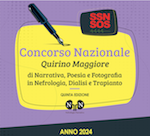Communication as an instrument for the empowerment of hemodialysis patients
DOI:
https://doi.org/10.33393/gcnd.2019.501Keywords:
Hemodialysis patients, Educational interventions, Empowerment, NursingAbstract
When a patient with chronic renal failure is told he must undergo hemodialysis, he/she lives an emotional shock, followed by a phase of anxiety. If this shock can’t be overcome, the patient can face some anxious-depressive pathologies that will complicate the already complex clinical picture. The aim of this work is to demonstrate how the communicative/educational measures are the clinical instruments, applied especially by nurses, that lead the patient to the acquisition of different skills (such as self-reliance and psycho-social abilities). In conclusion, an efficient communication, mainly based on active and participative listening, represents the most effective instrument for the patient with chronic-degenerative pathologies to promote the awareness of his own capacities of self-management, and to make him play a leading role in his own health. (narrative nephrology)
Downloads
Downloads
Published
How to Cite
Issue
Section
License
Authors contributing to Giornale di Clinica Nefrologica e Dialisi (GCND) agree to publish their articles under the CC-BY-NC 4.0 license, which allows third parties to re-use the work without permission as long as the work is properly referenced and the use is non-commercial.











